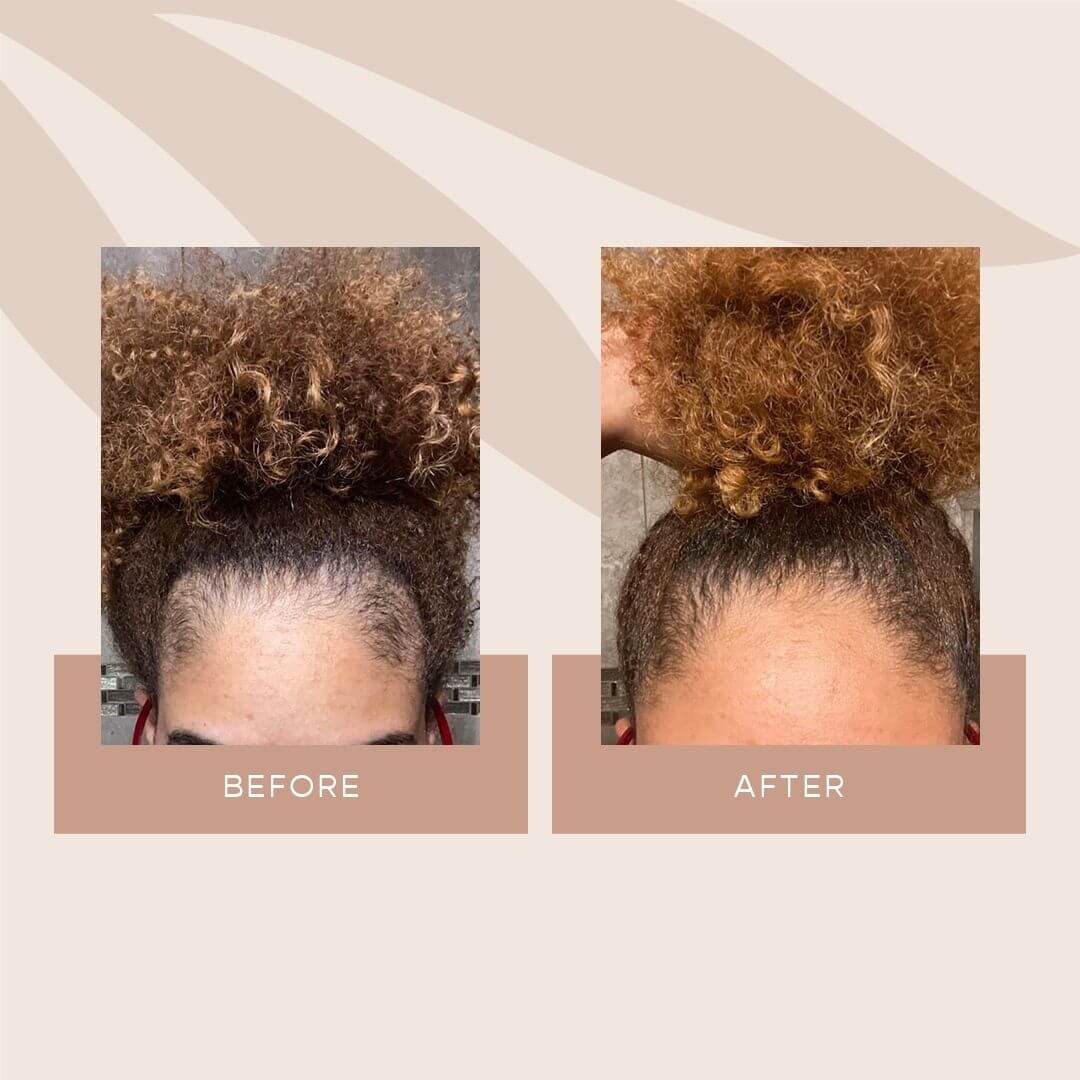While hair loss and thinning on more hidden areas of the scalp might go unnoticed at first, hair loss at the frontal hairline is hard to ignore. Your frontal hairline (where your forehead meets your scalp) is a big part of your facial appearance, so thinning hair or loss there can be alarming and downright distressing.
What causes female hair loss at the frontal hairline? Read on to uncover more about the potential causes and treatments, along with what products you should use to combat thinning hair ASAP.
What Can Cause Hair Loss at the Frontal Hairline?
Frontal hair loss in females can occur for various reasons. With that said, here are some of the most common reasons you might start to see hair loss along the frontal hairline.
Androgenetic Alopecia
Also known as AGA, androgenetic alopecia is a hair loss condition that is not fully understood but is believed to be caused by a combination of genetics, hormones and aging. AGA goes by many different names, including:
- Androgenic alopecia
- Genetic hair loss
- Female pattern hair loss
- Female pattern baldness
“AGA is a common form of hair loss that affects both men and women,” said Dr. Eugene Symaco, an internal medicine physician with Mayflower Medical. While hair loss affecting the frontal hairline (a receding hairline) is more often seen in men with AGA, women might notice their hairline being impacted.
“In women, AGA typically presents as diffuse thinning over the entire scalp, with the most noticeable hair loss along the frontal and temporal hairline,” said Dr. Symaco. “However, some women may experience more localized hair loss that is confined to the frontal hairline only.”
Shop: Best Products to Combat Thinning Hair
Telogen Effluvium
Telogen effluvium is a temporary hair loss condition that is typically triggered by a stressful event, whether it be psychological or physical. The stressor causes the body to shift a disproportionate amount of hair from the growth phase into the resting phase.
After about three months in the resting phase, TE becomes visible when the resting hairs are shed. Unfortunately, it can be a jarring experience because a lot of hair is shed in a relatively short period of time. While the excessive hair loss caused by TE typically happens throughout the scalp, you might notice your frontal hairline is impacted. The sudden hair loss associated with telogen effluvium does not result in complete hair loss — it typically resolves on its own and is not permanent.
Shop: GRO Revitalizing Scalp Massager
Frontal Fibrosing Alopecia
“A condition specific to the frontal part of the scalp is frontal fibrosing alopecia, which is where inflammation and scarring lead to permanent hair loss in this area,” said Julia Walker, a registered nurse with Paloma Health. Frontal fibrosing alopecia is part of hair loss conditions that are referred to as “scarring alopecia” since these conditions cause inflammation and scarring around hair follicles that leads to permanent hair loss.
With this hair loss condition, the frontal hairline slowly recedes, and eyebrows are commonly affected, too. It’s considered a variation of an inflammatory skin condition called lichen planopilaris, which most often affects postmenopausal women. While the exact causes of both frontal fibrosing alopecia and lichen planopilaris are unknown, research indicates that things like hormonal changes, autoimmune diseases and environmental factors might all be responsible.
See: 7 Autoimmune Diseases That Might Cause Hair Loss
Trichotillomania
Trichotillomania, also known as hair-pulling disorder, is a condition where people pull out their hair and find it hard to stop. If the frontal hairline is being pulled, it could result in bald patches or general thinning in the area. Most often, if the hair pulling is treated, the affected areas can return to regular hair growth. However, if the pulling is chronic and lasts over a long period, the follicles may be permanently damaged.
Get the Full Picture: Trichotillomania Explained
Traction Alopecia
Traction alopecia is another hair loss condition that can affect the frontal hairline. It results from repeated stress on the hair follicles from hair styling practices or tight hairstyles.
Tight ponytails or braids that pull hair with a lot of force wear on the follicles over time, and eventually, the affected follicles stop growing hair. Because tight hairstyles often pull on the temporal parts of the scalp, you might notice that part of the frontal hairline is impacted first.
Research shows that early diagnosis and treatment of TA can result in a reversal of hair loss, but late-stage TA can result in permanent hair loss.
Other Medical Conditions
“Hair loss is surprisingly common in certain health conditions,” said nurse Walker. Thyroid issues, autoimmune conditions and nutritional deficiencies can all lead to thinning hair or hair loss.
- Thyroid Disease: The thyroid is an important gland that regulates our metabolism. “When there is not enough thyroid hormone, cells assume they need to slow down,” explained Walker. “So, along with symptoms like a slower heart rate, constipation and dry skin, people with an underactive thyroid (or hypothyroidism) can experience slowed hair growth.”
- Autoimmune Conditions: Autoimmune conditions like Hashimoto’s (another form of thyroid disease) and lupus can also cause hair loss along the frontal hairline. “People with autoimmune conditions often have nutritional absorption issues as well, which can make it more difficult to get the nutrients they need to support hair growth,” said Walker.
- Nutritional Deficiencies: Iron deficiency might be among the more common nutritional deficiencies that cause hair loss, but a lack of biotin, zinc and selenium (among others) could cause hair thinning that impacts your frontal scalp.
- Conditions Affecting Blood Flow: “Conditions that affect blood flow can also affect hair growth,” said Walker. “For example, people with Type 2 diabetes are at risk for hair loss, as too much sugar in the blood cause damage to the smaller (and larger) vessels that nourish the skin and surrounding hair follicles.”
Because there are so many different hair loss or medical conditions that could impact your frontal hairlines, it's important to consult with a medical professional for diagnosis.
Related: Can a Dermatologist Help With Hair Loss?
How Is Frontal Hair Loss in Females Diagnosed?
When you see a medical doctor or a certified trichologist, they will work to rule out other common causes of hair loss like central centrifugal cicatricial alopecia, or alopecia areata, for example.
This will include getting a full picture of the hair loss and your medical history. They may also order blood tests to investigate possible hormonal changes and to check for vitamin or mineral deficiencies. Sometimes doctors will also take a small scalp biopsy to more closely examine your follicles and their functioning.
How Is Frontal Hairline Loss Treated?
Hair loss treatment depends on what your doctor uncovers as to the underlying cause. Your doctor might prescribe topical medications and/or oral medications to manage inflammation or to regulate your immune system.
Regardless of the underlying cause, though, experts agree that early diagnosis and swift medical treatments can go a long way in slowing or even reversing several types of hair loss.
In addition to medically treating the underlying causes of hair loss, other cosmetic treatments like laser therapy, platelet-rich plasma (PRP) injections and hair transplantation surgery are available.
Tips for Managing Hair Loss and Supporting Holistic Hair Wellness
If you notice thinning hair or loss at the frontal hairline, “gentle” needs to become the name of your hair care game. “Aside from following the plan recommended by your doctor to treat any underlying conditions, make sure to care for your hair and scalp carefully,” said Walker. “You will want to avoid anything that worsens inflammation or irritation in this area.”
Switch Up Your Shampoo
Gentle extends to everything from hair care practices to products, so think about adding gentle, all-natural shampoos and conditioner for thinning hair to avoid potential irritation that comes from the synthetic ingredients in many hair products.
Use a Hair Serum to Get Encourage Thicker, Fuller Looking Hair
Also, consider adding a hair serum to your routine, like our GRO+ Advanced Hair Serum. It features powerful phyto-actives to support and encourage thicker, fuller looking hair.
Check out this story from Ayla: "I got the GRO+ Advanced Hair Serum and have been on it for about two months now. It’s the only thing I have used and will continue to use. Not only did my edges grow back, my hair was healthier and my curls looked soooooo good! If I had any advice it would be to stay calm, and try VEGAMOUR. You really only have one thing to lose (money) and everything to gain. I was that skeptical girl and I'm so glad I gave it a try."
Take a Holistic Approach to Hair Wellness
And to support your hair wellness from the inside out, take a holistic approach. Get enough sleep and manage stress levels with exercise and meditation. Also, eat a well-balanced and healthy diet and fill in the gaps with hair-friendly supplements, like biotin gummies.
The Takeaway
Hair thinning and loss at the frontal hairline could be a symptom of several different hair loss or medical conditions. If you’ve noticed hair loss along your frontal hairline, it's important to see a doctor to address the underlying causes of the loss.
Early diagnosis and prevention is the best way to slow the progression of hair loss and possibly even encourage regrowth. And focusing on sleep, diet, exercise, hair wellness practices and stress management are additional tools to help support a healthy hair ecosystem.
#include-related-slider#
More From VEGAMOUR
- Avoid These Things If You Have Thinning Hair
- How Often Should You Wash Thinning Hair?
- How Much Hair Shedding Is Too Much?
Photo credit: Dollar Gill/Unsplash
Back



















